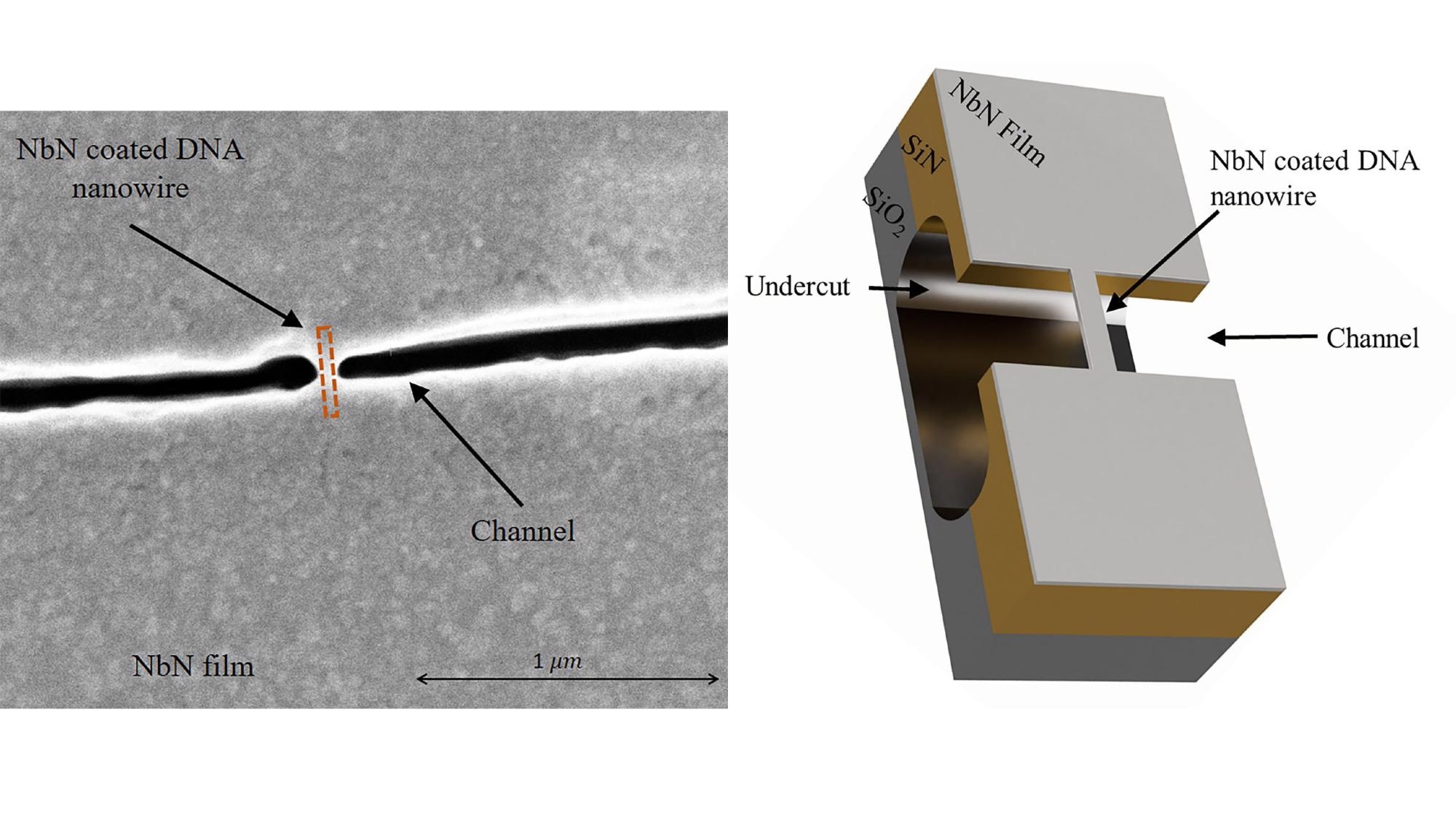Jan 20 2021
The search for ever-smaller electronic components has made an international research group examine the use of molecular building blocks to develop them.
 (Left) Schematic illustration of a niobium nitrate-coated DNA nanowire suspended above a silicon nitride/silicon oxide channel. (Right) High-resolution scanning electron microscope (HR-SEM) image of the channel (black in image) on which the DNA nanowire is suspended. In the image, the channel appears discontinuous, reflecting the DNA suspended across it (marked by dashed orange rectangle). The distance between the two sides of the channel is ~50 nm, and the width of the niobium nitrate-coated nanowire at its narrowest point is ~25 nm. Image Credit: Lior Shani, Philip Tinnefeld, Yafit Fleger, Amos Sharoni, Boris Shapiro, Avner Shaulov, Oleg Gang, and Yosef Yeshurun.
(Left) Schematic illustration of a niobium nitrate-coated DNA nanowire suspended above a silicon nitride/silicon oxide channel. (Right) High-resolution scanning electron microscope (HR-SEM) image of the channel (black in image) on which the DNA nanowire is suspended. In the image, the channel appears discontinuous, reflecting the DNA suspended across it (marked by dashed orange rectangle). The distance between the two sides of the channel is ~50 nm, and the width of the niobium nitrate-coated nanowire at its narrowest point is ~25 nm. Image Credit: Lior Shani, Philip Tinnefeld, Yafit Fleger, Amos Sharoni, Boris Shapiro, Avner Shaulov, Oleg Gang, and Yosef Yeshurun.
DNA has the ability to self-assemble into arbitrary structures, but the difficulty faced while making use of these structures for nanoelectronic circuits is that it is essential to transform the DNA strands into highly conductive wires.
Drawing inspirations from earlier works that involved the use of the DNA molecule as a template for superconducting nanowires, the research team leveraged a recent bioengineering advance called DNA origami to fold DNA into arbitrary shapes.
In the AIP Advances journal, from AIP Publishing, scientists from Bar-Ilan University, Ludwig-Maximilians-Universität München, Columbia University, and Brookhaven National Laboratory explain how to utilize DNA origami as a platform to construct superconducting nanoarchitectures.
The structures constructed by the team can be addressed with nanometric precision that can be utilized as a template for 3D architectures that are currently impossible through traditional fabrication methods.
The fabrication process of the research team includes a multidisciplinary method, specifically the transformation of the DNA origami nanostructures into superconducting components. Additionally, the preparation process of DNA origami nanostructures includes two significant components: a circular single-strand DNA acting as the scaffold, and a blend of complementary short strands serving as staples that establish the structure’s shape.
In our case, the structure is an approximately 220-nanometer-long and 15-nanometer-wide DNA origami wire. We dropcast the DNA nanowires onto a substrate with a channel and coat them with superconducting niobium nitride. Then we suspend the nanowires over the channel to isolate them from the substrate during the electrical measurements.
Lior Shani, Bar-Ilan University
The team’s research demonstrates how to make use of the DNA origami method to fabricate superconducting components that can be integrated into an extensive range of architectures.
Superconductors are known for running an electric current flow without dissipations. But superconducting wires with nanometric dimensions give rise to quantum fluctuations that destroy the superconducting state, which results in the appearance of resistance at low temperatures.
Lior Shani, Bar-Ilan University
The researchers applied a high magnetic field to suppress these fluctuations and minimized around 90% of the resistance.
This means that our work can be used in applications like interconnects for nanoelectronics and novel devices based on exploitation of the flexibility of DNA origami in fabrication of 3D superconducting architectures, such as 3D magnetometers.
Lior Shani, Bar-Ilan University
Journal Reference:
Shani, L., et al. (2020) DNA origami based superconducting nanowires. AIP Advances. doi.org/10.1063/5.0029781.